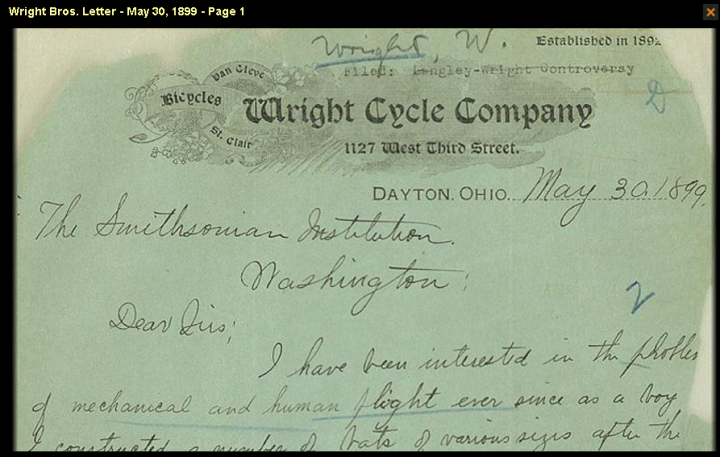
Powered, controlled flight is a scientific and engineering achievement rich with examples of scholarly communication. Background sources provide a foundation. Correspondence provides insight into challenges and developments in a field. Experimental findings shared via professional meetings and journal articles encourage wider discussion and further exploration. Scholarly conversations between the Wright brothers and Octave Chanute preserved in digital collections at the Library of Congress provide a rich exemplar for students learning about scholarly communication.
Thanks to the Library of Congress Digital Collections we can see many of the documents including letters and notebooks.
Wilbur and Orville Wright Papers at the Library of Congress
Thanks to the Hathi Trust we have access to many of the same documents in a readable, text format.
The Wright Brothers’ story is documented widely. Provided here are some highlights with respect to scholarly communication.
Background reading
Examples such as books listed below provided a foundation for the Wright brothers as they began acquiring knowledge.
Animal Mechanism: A Treatise on Terrestrial and Aerial Locomotion by Etienne Jules Marey, 1874.
Animal Locomotion; or Walking, Swimming, and Flying, with a Dissertation on Aeronautics by J. Bell Pettigrew, 1874.
Ask an expert
Wilbur Wright asked the Smithsonian Institution for help in finding more information about flight. Richard Rathbun, Assistant Secretary, sent pamphlets and a bibliography for further reading.
“I wish to avail myself of all that is already known and then if possible add my mite to help on the future workers who will attain final success.”
Letter to the Smithsonian Institution by Wilbur Wright, 1899.
Subsequently, Wilbur Wright began a ten year correspondence with Octave Chanute, engineer and aeronautic leader. Their letters continue this exemplar of scholarly communication.
Conference presentations
In presenting information to a wider audience researchers are forced to clarify meaning and acknowledge inconsistencies. Wilbur Wright faced this challenge in his first address to the Western Society of Engineers on September 18, 1901. In this speech he described early Kitty Hawk glider experiments and the discrepancies that he and his brother found between their results and the published, accepted research data of the time. After this speech the brothers embarked on their quest for a resolution by building a wind tunnel and testing various airfoils, thereby collecting new data under controlled conditions. Results from the wind tunnel testing in 1901 were crucial to the development of a new glider for 1902.
Some Aeronautical Experiments – From the Smithsonian Report for 1902 – based on the speech given to the Western Society of Engineers in September 1901.
Conclusion
From glider tests of 1902 the Wright brothers developed the aircraft that flew on December 17, 1903. That discreet date is often used as an endpoint of the story, but it is only one milestone among many developments still happening today.
The study of the history of aviation is rich with examples of scholarly communication. This blog post touches on a few. Concepts about research data management and intellectual property, plus the ACRL Framework for Information Literacy could be explored as well.
Jennifer Roach, Co-Chair, Science Resources: Discovery and Access Committee, jroach75 at gmail.com
We welcome your comments and suggestions. If you have a resource that you would like to see highlighted please leave us a comment.


One thought on “Scholarly Communication and the History of Flight”